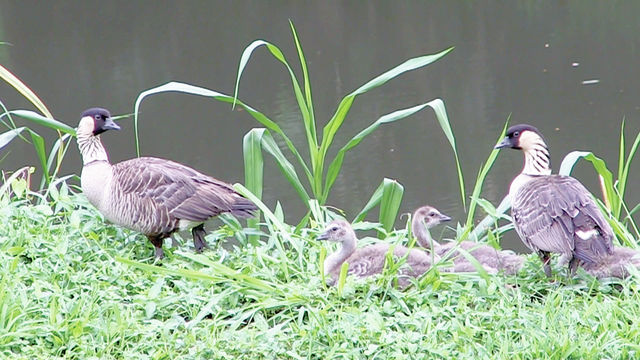LIHUE — Two of three baby nene photographed grazing in lush grass alongside the Hanalei River last month were killed by cars as they attempted to cross a highway.
A video shot by the Department of Land and Natural Resources and distributed to media across the state on Dec. 28 showed a family of nene; mother, father and their three goslings resting and eating on the stream’s bank underneath the Hanalei Bridge.
Last week, two goslings were struck and killed.
“Many of these deaths are preventable if drivers would simply heed warning signs, slow down, and exercise caution in areas where nene families commonly breed, nest, and raise their young,” said Jean Olbert, biologist with the DLNR Division of Forestry and Wildlife who specializes in protection of nene on Kauai.
Olbert and other state biologists continue to look for novel ways to get the word out about nene road strikes. Their first goal is to increase awareness to visitors on the island who may be less familiar with the native wildlife.
DLNR reported road strikes happen on other islands, but have been particularly bad on Kauai recently with 11 birds struck and killed by vehicles since last December. More than 50 birds have been killed in this manner in the past two years.
On Kauai, the worst locations for nene deaths are around the Hanalei Bridge, on Kilauea Road near the Kilauea Point National Wildlife Refuge and on the Westside of the island. In the final weeks of 2016, eight Hawaiian geese were killed by vehicles along a two-mile stretch of the Kaumualii Highway in Kekaha.
The greatest number of road deaths occur between December and April during the peak breeding and molting season. During this time, both adults and goslings can’t fly and are especially vulnerable to passing cars and trucks. Nene like to forage for food along highway edges and ditches that are regularly mowed. Runoff from paved surfaces helps grow especially desirable grass in these areas.
DLNR is opening discussions with the Department of Transportation and Kauai County to explore reducing and/or changing roadside vegetation that isn’t as attractive to nene.
Nene crossing signs have recently been posted by the Department of Transportation along Kaumualii Highway in Kekaha and Kuhio Highway in Hanalei in regions where birds frequently cross roadways. More signs may be added.
Nene are only found in Hawaii and are listed as endangered due to their low number, with an estimated 1,200 remaining on Kauai.
It is believed that 25,000 nene were present in the Hawaiian Islands when Captain Cook arrived in 1778. By the mid-1940s only 50 birds remained. Since then, through captive breeding efforts and extensive predator control the population is beginning to grow with almost 3,000 birds statewide.
Even with ongoing conservation efforts, nene are still considered the rarest goose species in the world.
Olbert said most birds are killed on roads in the early morning and evening hours.
“There’s a nene crossing warning sign within 25 feet of where video and photographs of the family were taken.”



